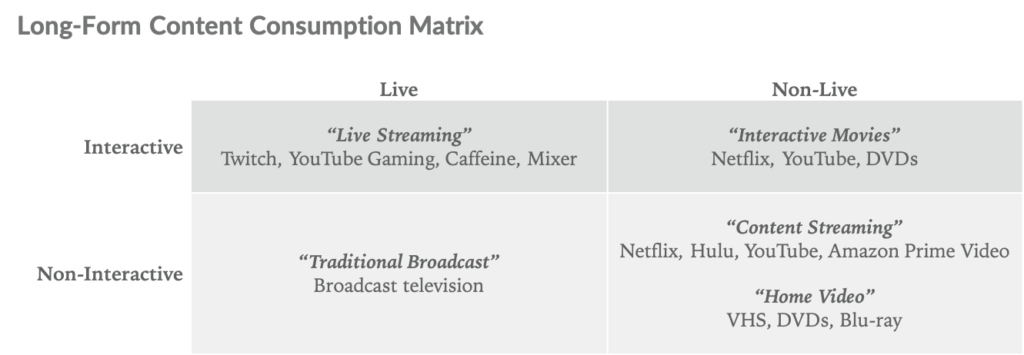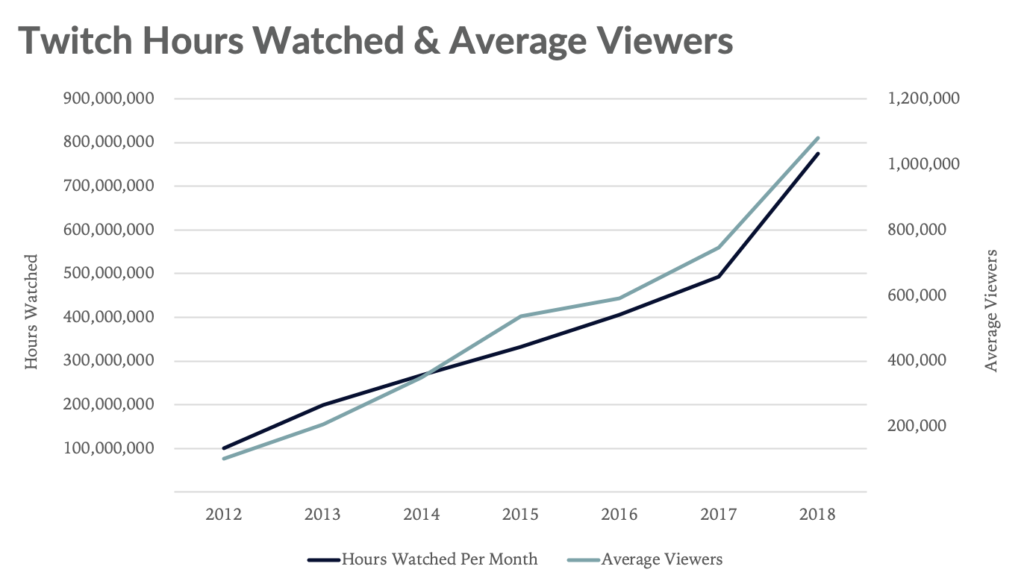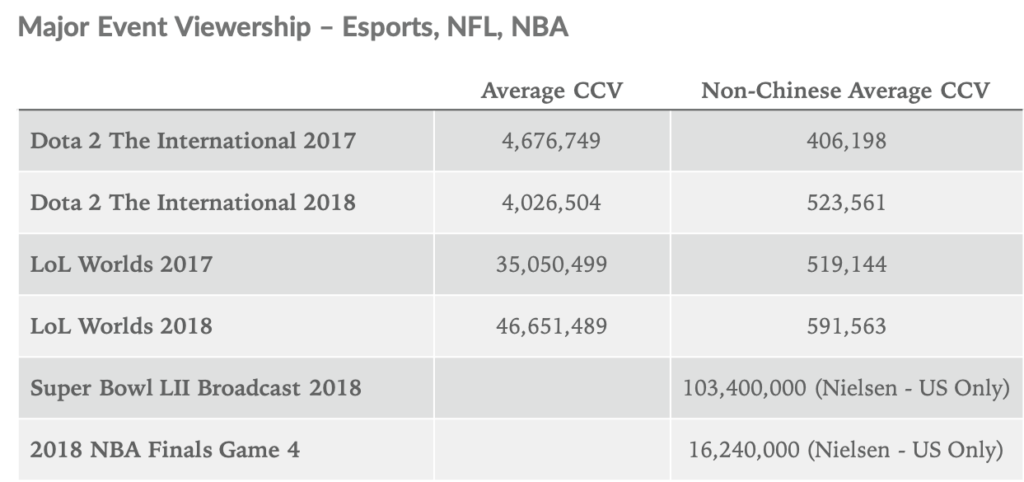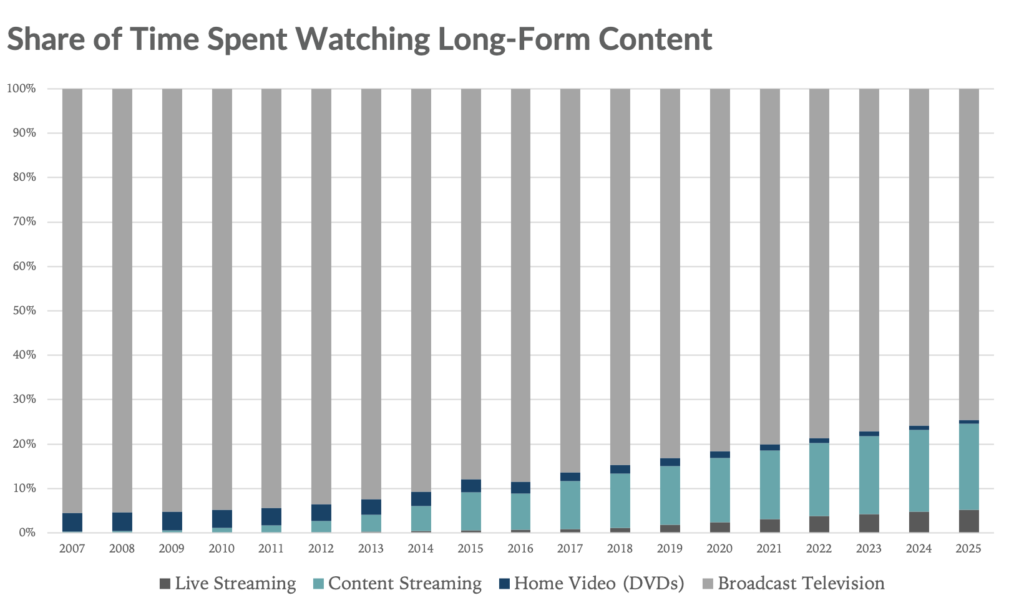Live streaming has exploded over the past few years as a dangerous competitor to traditional broadcasting and content streaming. While platforms like Twitch, YouTube Gaming, Facebook Live, Mixer, and Caffeine have predominantly featured gaming content, they’re quickly expanding into other content types. We think these platforms will rise to become a much more meaningful part of our content consumption mix over the next 5 to 10 years.
Why Do Live Streaming Platforms Matter?
Live-streaming platforms offer interactive content to their audience. We define “interactive” as any content that the audience can influence: participating in a chat room, cheering on a content creator (streamer) by donating to a stream, or interacting with an extension tool on a given platform. New extension tools are created every day to improve audience engagement. Common examples would be a poll, viewer leaderboard, or even an option to request songs played during a stream.
We break out existing long-form video content consumption platforms into the following groups. We consider long-form content to be anything longer than 15 minutes. We consider “live” to be any content for which the audience cannot control the start time.

There aren’t many examples of interactive, non-live content today. Commenting on a YouTube video is interactive, but time displaced and a comment only affects the experience with the content to the extent viewers read the comments. There are also interactive shows, like the recently released Black Mirror: Bandersnatch. While Bandersnatch had generally positive reception, we don’t think that the format is as engaging and promising as live, interactive content.
What Does the Future of Interactive Entertainment Look Like?
Three pieces of evidence support the rise of live streaming platforms and hint towards their future opportunity:
- Gaming Viewership Is Increasing and Lives on Live Streaming Platforms
- Traditional Sports Are Finding New Ways to Broadcast Content
- Traditional Content Is Testing the Interactive Waters
1 – Gaming Viewership Is Increasing and Lives on Live Streaming Platforms
More and more people are spending time watching gaming. Over the last 5 years, the average number of viewers on Twitch has risen 420%, while the number of hours watched per month is up 287%.

Esports also offers evidence of the growing popularity of gaming as a passive entertainment medium. The last League of Legends (LoL) World Championship drew a peak of 205 million viewers with an average of 46 million concurrent viewers (CCV). Note that this data is global and a vast majority (~99%) of LoL viewership for Worlds 2018 came from Asia. When you adjust esports viewership for non-Chinese viewers the audiences look much different:

Esports viewership will continue to grow in the US driven by growth in the number of gamers, establishing franchise esports leagues, and launching high school esports teams. More high-quality gameplay content will drive users to interactive live streaming platforms.
2 – Traditional Sports Are Finding New Ways to Broadcast Content
Whether you watch the NFL on FOX through the NFL app or on Twitter, the delivery has largely been the same over the last few decades. In late 2018, Twitch changed this paradigm by live streaming NFL games. Twitch and the NFL select a few of Twitch’s top content creators to stream a Thursday Night Football game to provide supplementary commentary during the game, similar to an additional sportscaster. The audience can participate in chat alongside the streamer during the game, creating a fundamentally different experience for the viewer than a traditional live broadcast.
We expect live streaming platforms to leverage more partnerships like the one between Twitch and the NFL where content creators have access to traditional sports and other live broadcasts to provide new entertainment experiences. While this would result in some loss of control by the leagues, it would mean more relevant broadcasts for their viewer bases and higher engagement overall. Some fans may be interested in a highly technical approach to the game, others may be interested in a lighter, more humorous approach, and others may want to see some more lively trash talk. Interactive platforms allow content creators to offer viewers a differentiated experience in watching the game.
3 – Traditional Content Is Testing the Interactive Waters
As sports broadcasts become more interactive, traditional pre-recorded content will follow a similar route. A recent example is the Inspector Gadget Christmas Eve Twitch broadcast. During the broadcast, one of the co-creators watched along with the audience and shared details about the making of the show. Inspector Gadget isn’t the first show to test a live stream on Twitch. Other streaming marathons have included Pokemon, Doctor Who, and Power Rangers.
What Does the Future of Long-Form Content Consumption Look Like?

According to Nielsen, until 2007, almost all long-form content consumption was broadcast television (live, non-interactive) with a very small portion from DVD and VHS (non-live, non-interactive). The launch of streaming platforms like Netflix and Hulu, as well as the popularity of DVRs, pushed people to spend more time consuming non-live, non-interactive content. We estimate that content streaming (e.g., Netflix) accounted for 11% of long-form content hours watched in the US in 2018. We think this will grow to 19% by 2025 as people continue to cut the cord on television.
Only about 1% of all long-form content consumption happens on live streaming platforms today. As outlined above, the continued growth of gaming, the addition of live sports, and the expansion into traditional content will drive live streaming consumption. We think live streaming (e.g., Twitch) will grow to 5% of consumption by 2025.
Live streaming platforms offer something unique that content streaming platforms do not: the ability for creators to monetize their content. The barriers to getting content on Netflix or Hulu are high. Live streaming has democratized content creation. In the long run, we think the freedom in live streaming platforms will provide consumers with more choice and thus more relevant content. Viewership is likely to follow.
Disclaimer: We actively write about the themes in which we invest or may invest: virtual reality, augmented reality, artificial intelligence, and robotics. From time to time, we may write about companies that are in our portfolio. As managers of the portfolio, we may earn carried interest, management fees or other compensation from such portfolio. Content on this site including opinions on specific themes in technology, market estimates, and estimates and commentary regarding publicly traded or private companies is not intended for use in making any investment decisions and provided solely for informational purposes. We hold no obligation to update any of our projections and the content on this site should not be relied upon. We express no warranties about any estimates or opinions we make.
